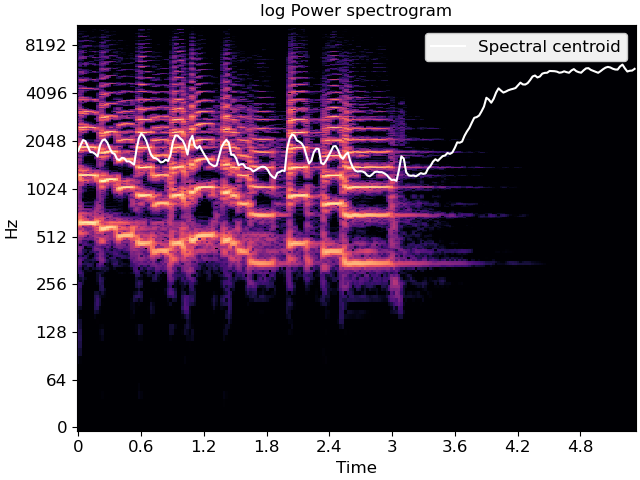Caution
You're reading the documentation for a development version. For the latest released version, please have a look at 0.11.0.
librosa.feature.spectral_centroid
- librosa.feature.spectral_centroid(*, y=None, sr=22050, S=None, n_fft=2048, hop_length=512, freq=None, win_length=None, window='hann', center=True, pad_mode='constant')[source]
Compute the spectral centroid.
Each frame of a magnitude spectrogram is normalized and treated as a distribution over frequency bins, from which the mean (centroid) is extracted per frame.
More precisely, the centroid at frame
tis defined as [1]:centroid[t] = sum_k S[k, t] * freq[k] / (sum_j S[j, t])
where
Sis a magnitude spectrogram, andfreqis the array of frequencies (e.g., FFT frequencies in Hz) of the rows ofS.- Parameters:
- ynp.ndarray [shape=(…, n,)] or None
audio time series. Multi-channel is supported.
- srnumber > 0 [scalar]
audio sampling rate of
y- Snp.ndarray [shape=(…, d, t)] or None
(optional) spectrogram magnitude
- n_fftint > 0 [scalar]
FFT window size
- hop_lengthint > 0 [scalar]
hop length for STFT. See
librosa.stftfor details.- freqNone or np.ndarray [shape=(d,) or shape=(d, t)]
Center frequencies for spectrogram bins. If None, then FFT bin center frequencies are used. Otherwise, it can be a single array of
dcenter frequencies, or a matrix of center frequencies as constructed bylibrosa.reassigned_spectrogram- win_lengthint <= n_fft [scalar]
Each frame of audio is windowed by window(). The window will be of length
win_lengthand then padded with zeros to matchn_fft. If unspecified, defaults towin_length = n_fft.- windowstring, tuple, number, function, or np.ndarray [shape=(n_fft,)]
a window specification (string, tuple, or number); see
scipy.signal.get_windowa window function, such as
scipy.signal.windows.hanna vector or array of length
n_fft
- centerboolean
If True, the signal
yis padded so that frame t is centered aty[t * hop_length].If False, then frame
tbegins aty[t * hop_length]
- pad_modestring
If
center=True, the padding mode to use at the edges of the signal. By default, STFT uses zero padding.
- Returns:
- centroidnp.ndarray [shape=(…, 1, t)]
centroid frequencies
See also
librosa.stftShort-time Fourier Transform
librosa.reassigned_spectrogramTime-frequency reassigned spectrogram
Examples
From time-series input:
>>> y, sr = librosa.load(librosa.ex('trumpet')) >>> cent = librosa.feature.spectral_centroid(y=y, sr=sr) >>> cent array([[1768.888, 1921.774, ..., 5663.477, 5813.683]])
From spectrogram input:
>>> S, phase = librosa.magphase(librosa.stft(y=y)) >>> librosa.feature.spectral_centroid(S=S) array([[1768.888, 1921.774, ..., 5663.477, 5813.683]])
Using variable bin center frequencies:
>>> freqs, times, D = librosa.reassigned_spectrogram(y, fill_nan=True) >>> librosa.feature.spectral_centroid(S=np.abs(D), freq=freqs) array([[1768.838, 1921.801, ..., 5663.513, 5813.747]])
Plot the result
>>> import matplotlib.pyplot as plt >>> times = librosa.times_like(cent) >>> fig, ax = plt.subplots() >>> librosa.display.specshow(librosa.amplitude_to_db(S, ref=np.max), ... y_axis='log', x_axis='time', ax=ax) >>> ax.plot(times, cent.T, label='Spectral centroid', color='w') >>> ax.legend(loc='upper right') >>> ax.set(title='log Power spectrogram')
